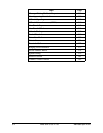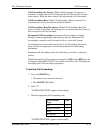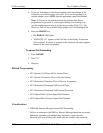
Key Telephone Features Call Coverage Groups
Revised April 2000 DBS 824-3.0/3.2-700 3-9
For example, if an outside call on line 1 is sent to extension 135, but
extension 135 does not answer, the call will ring once when the call first
comes in at the covering phone and “TRK #01> 135” will appear on the
covering phone’s display.
If two extensions are designated as covering phones and the first in DND, the
second will receive the call.
Call coverage assignments are controlled through system programming,
rather than from individual extensions.
For extension-controlled routing of unanswered calls, see “Call Forwarding”
on page 3-10.
Related Programming
• FF3 (Extension): Offhook Signal
• FF4 (Ringing and Hunt Groups): Call Coverage Group Member Table
Considerations
• Up to four Call Coverage Groups can be programmed into your system. A
Call Coverage Group can have up to two covering phones and up to six
extensions.
• A member of one Call Coverage Group cannot belong to another Call
Coverage Group or to a Hunting Group.
• A single-line telephone (SLT) can be a member of a coverage group, but it
cannot be a covering phone.
• Calls to an extension in DND do not cover.
• Calls to an extension with Call Forwarding activated do not cover.
• If the Call Forwarding feature or the Absence Message feature is activated
for covering phone No. 1, covering phone No. 2 will “cover” the other
extensions in the group.
• Voice intercom calls do not activate call coverage. Only tone intercom
calls can activate call coverage.


















